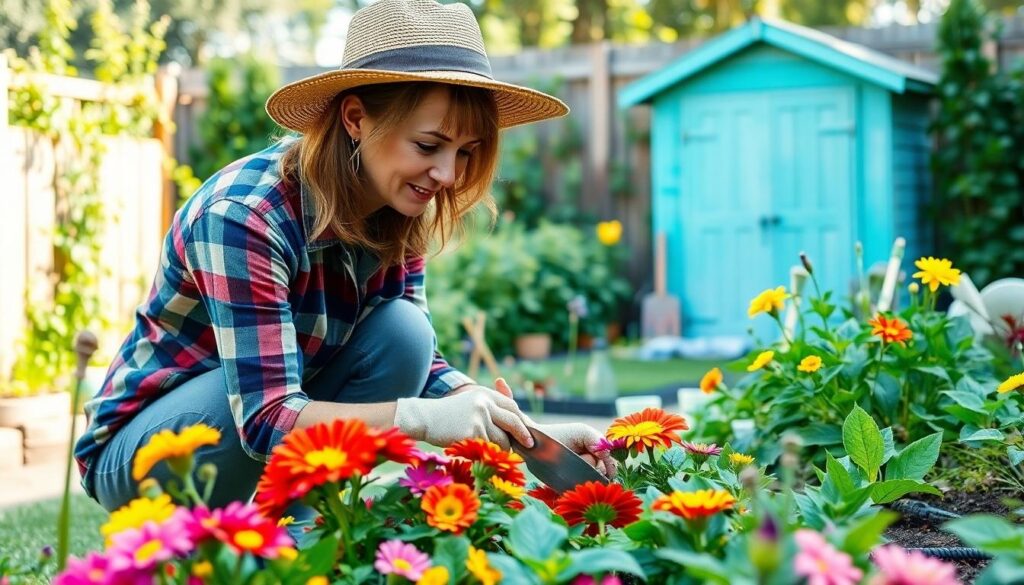We often view our gardens as peaceful sanctuaries, but beneath that serene exterior lurk potential hazards that many homeowners overlook. From toxic plants to dangerous tools, these hidden garden dangers can pose serious risks to children, pets, and even adults when left unaddressed.
In our years of landscaping expertise, we’ve encountered countless gardens harboring silent threats. Did you know that common plants like foxglove and lily of the valley contain compounds toxic enough to cause serious illness? Or that standing water in garden features can become breeding grounds for disease-carrying mosquitoes? These everyday elements transform beautiful outdoor spaces into potential danger zones.
10 Hidden Garden Dangers Every Homeowner Should Know
- Toxic Plants – Many common garden plants contain poisonous compounds that can harm humans and pets. Foxglove contains digitalis that can cause cardiac issues if ingested. Lily of the valley produces cardiac glycosides that are particularly dangerous to children and pets. We recommend researching any new plants before adding them to your garden, especially if you have curious pets or young children.
- Standing Water – Even small amounts of stagnant water can become breeding grounds for mosquitoes within days. Bird baths, forgotten buckets, and poor drainage areas create perfect conditions for these disease-carrying insects. Regularly empty any containers collecting water and consider adding mosquito dunks to water features you can’t drain.
- Chemical Exposure – Pesticides, herbicides, and fertilizers can cause skin irritation, respiratory issues, or poisoning if mishandled. Many common garden chemicals contain compounds linked to long-term health effects. Always wear protective gear when applying these products and store them in locked cabinets away from children and pets.
- Sharp Tools – Garden tools left unattended pose serious injury risks, particularly to children. Pruning shears, garden forks, and hedge trimmers can cause deep cuts or puncture wounds if stepped on or mishandled. Store all tools properly after use in a secure location that’s inaccessible to children.
- Tetanus Risk – Garden soil often harbors Clostridium tetani bacteria that causes tetanus. Any puncture wound from rusty tools, thorny plants, or contaminated soil can introduce this dangerous bacterium. Ensure your tetanus vaccination is current (typically every 10 years) if you’re an active gardener.
- Hidden Trip Hazards – Garden hoses, roots, uneven pavers, and low retaining walls create fall risks that are easily overlooked. These hazards become particularly dangerous during low light conditions or when you’re carrying items. Keep pathways clear and consider installing industry lighting to illuminate potential trip zones.
- Ticks and Disease-Carrying Insects – Gardens with tall grasses, leaf piles, or wooded borders attract ticks that can transmit Lyme disease and other serious illnesses. These tiny parasites often hide in leaf litter and transfer to humans during gardening activities. Wear long sleeves, use insect repellent, and perform tick checks after working outdoors in tick-prone areas.
- Thorny Plants – Roses, blackberry bushes, and barberry contain sharp thorns that can cause painful punctures or scratches. These injuries can become infected if not properly cleaned. Plant thorny specimens away from walkways and play areas, and always wear thick gloves when pruning or maintaining these plants.
- Allergenic Plants – Common plants like ragweed, goldenrod, and certain grasses produce pollen that triggers allergic reactions in many people. Exposure to these plants can cause symptoms ranging from mild discomfort to severe respiratory distress. Consider removing highly allergenic plants if family members suffer from allergies, or wear a mask when working around them during peak pollen seasons.
- Electrical Hazards – Outdoor extension cords, lighting systems, and power tools create shock risks, especially when moisture is present. Damaged cords or improper connections in garden areas pose serious electrocution hazards during wet conditions. Use only outdoor-rated electrical equipment, install GFCI outlets for garden areas, and inspect all cords regularly for damage.
Toxic Plants That Can Harm Children and Pets
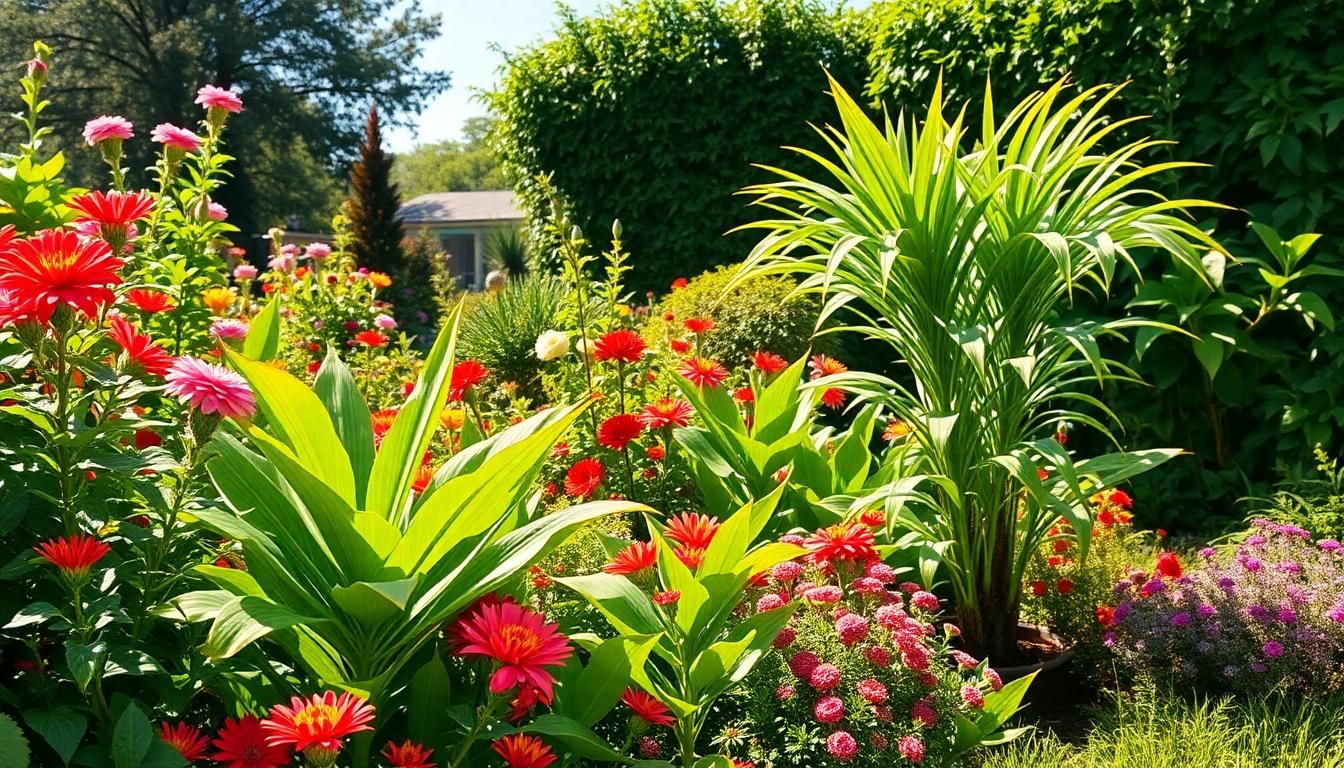
Many common garden plants harbor hidden toxins that pose serious risks to curious children and pets who might ingest them. Understanding which plants are dangerous and recognizing symptoms of poisoning can help prevent potentially fatal incidents.
Common Poisonous Garden Plants
- Sago Palms (Cycas revoluta) contain potent toxins concentrated in their seeds that can cause severe liver damage in pets. When ingested, these attractive palms trigger vomiting, diarrhea, and potentially fatal liver failure, making them particularly dangerous for households with animals.
- Castor Bean Plants (Ricinus communis) produce seeds containing ricin, one of nature’s most potent toxins. Ingestion results in bloody vomit, severe diarrhea, and can be fatal even in small amounts, presenting an extreme danger in residential gardens.
- Lilies are especially deadly to cats, with even minimal exposure potentially causing fatal kidney failure. Simply brushing against pollen and later grooming themselves can be enough to poison felines.
- Azaleas contain grayanotoxins that affect cardiac function. These popular flowering shrubs cause nausea and vomiting with small exposures, while larger amounts can lead to life-threatening conditions requiring immediate medical attention.
- Oleander ranks among the most poisonous plants commonly found in gardens. Every part of this ornamental plant contains toxic compounds harmful to both humans and animals, with even small amounts capable of causing serious illness.
- Caladium plants lead to immediate irritation of mucous membranes upon contact or ingestion. These colorful foliage plants trigger painful swelling and gastrointestinal distress when their calcium oxalate crystals contact sensitive tissues.
- Wisteria contains toxic compounds that cause substantial digestive upset. The beautiful climbing vine produces seeds and pods that induce vomiting, abdominal pain, and breathing difficulties, with large doses potentially proving fatal.
Symptoms of Plant Poisoning to Watch For
- Gastrointestinal Issues: Sudden onset of vomiting, diarrhea, or pronounced abdominal pain often indicates plant poisoning. These symptoms typically appear within hours of ingestion and may persist without proper treatment.
- Respiratory Problems: Difficulty breathing, wheezing, or unusual respiratory patterns require immediate medical attention. These symptoms suggest severe toxicity and potential airway compromise.
- Neurological Symptoms: Depression, weakness, stumbling, or unusual behavior changes may indicate neurotoxin exposure. Animals may appear disoriented or unusually lethargic after plant ingestion.
- Severe Conditions: Signs of liver toxicity (yellowing skin or eyes), toxic shock (collapse, pale gums), or important dehydration represent life-threatening emergencies requiring immediate veterinary or medical intervention.
- Prevention: Identify and remove toxic plants from areas accessible to children and pets. Constant supervision of young children and animals in garden spaces prevents accidental ingestion. Keep contact information for poison control centers (1-800-222-1222) and emergency veterinary services readily available.
Dangerous Garden Tools and Equipment
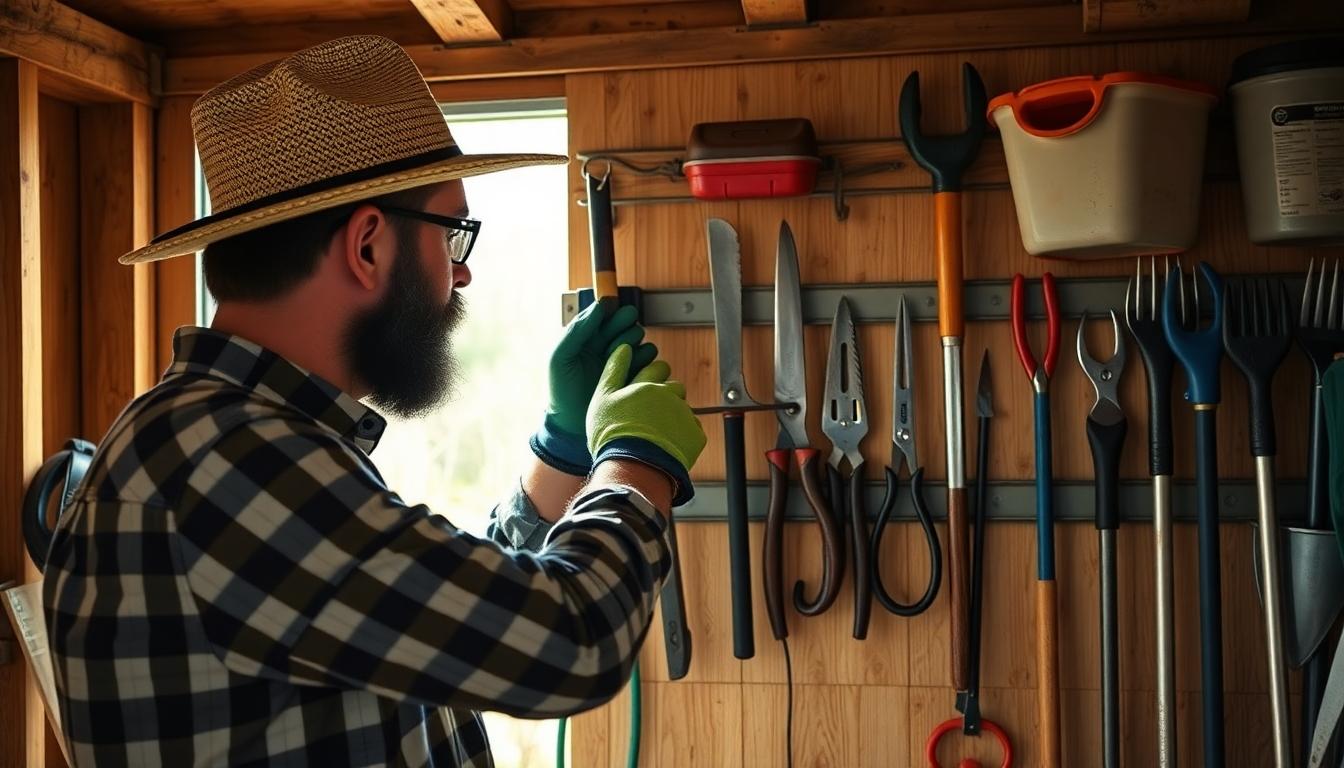
Garden tools and equipment represent important hidden dangers in our outdoor spaces. Sharp blades, heavy machinery, and electrical tools can cause serious injuries if not respected and handled with proper care.
Proper Storage Techniques for Garden Tools
Storing garden tools properly is essential for both safety and longevity. We recommend designating a dry, secure area specifically for tool storage to prevent damage and unauthorized access, especially by children. Tools should be cleaned regularly after each use to remove soil, plant debris, and moisture that can lead to rust and microbial growth. Organizing your equipment with proper labeling and designated spots makes it easier to locate tools when needed and helps prevent accidents from improper storage. Wall-mounted racks keep sharp tools off the ground and away from pathways where they might cause injury. For seasonal storage, applying a light coat of oil to metal parts prevents corrosion and ensures tools remain in optimal condition for the next gardening season.
Safety Features to Look For When Purchasing
When investing in new garden tools and equipment, safety features should be a top priority. Ergonomic designs significantly reduce musculoskeletal strain during extended use and help prevent long-term injuries to your back, wrists, and shoulders. Tools with safety guards covering blades and moving parts provide essential protection against accidental cuts and entanglement. Automatic shut-off mechanisms on power tools offer crucial protection if the tool is dropped or used improperly. Non-slip handles with textured grips prevent accidents during use, especially in wet conditions when tools can become slippery. Weight-balanced tools distribute force evenly and reduce fatigue, allowing for safer operation over longer periods. Electrical tools with GFCI protection help prevent shock hazards when working in damp garden environments. Visibility features such as bright colors make tools easier to locate and less likely to become trip hazards when temporarily set down during gardening tasks.
Chemical Hazards Lurking in Your Garden
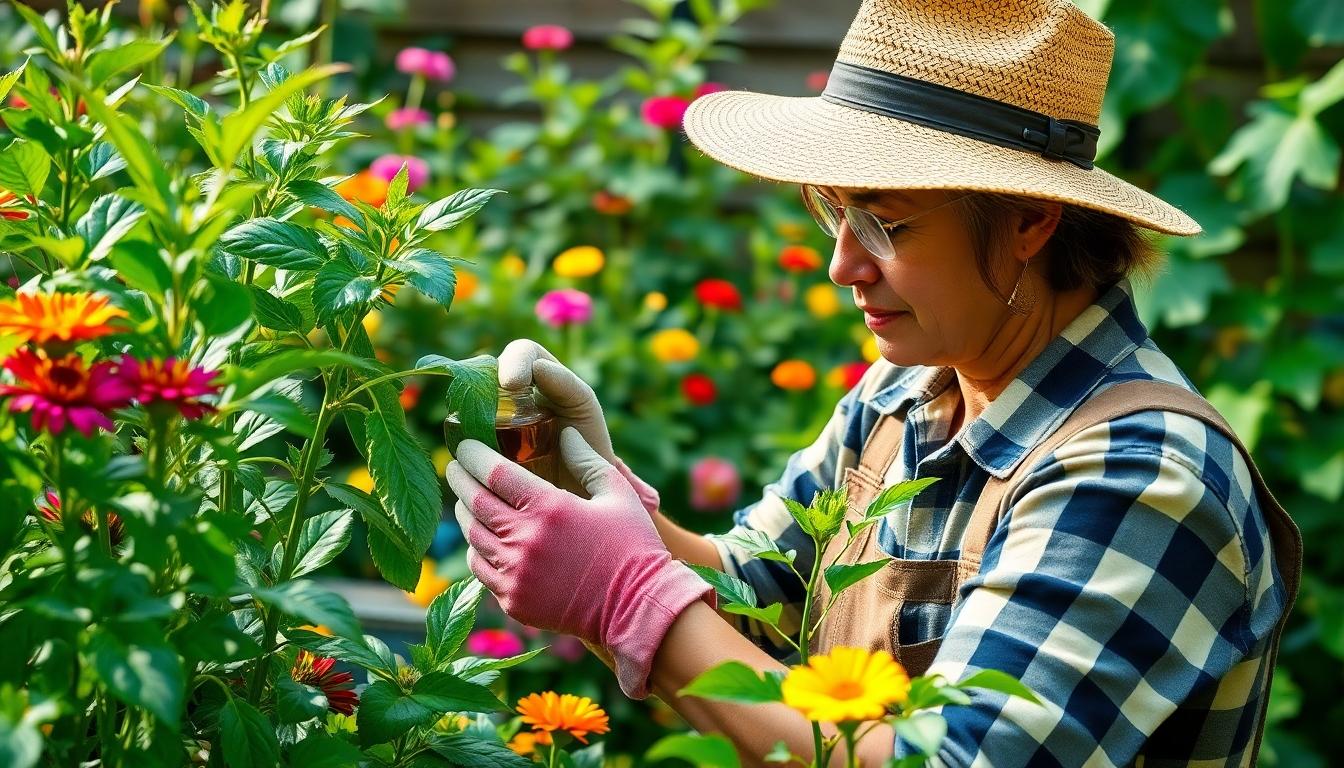
Many gardens harbor invisible threats in the form of synthetic chemicals that can harm both humans and the environment. These substances might seem harmless but actually contain compounds linked to serious health conditions and ecological damage.
Pesticides and Fertilizers That Pose Health Risks
Synthetic garden chemicals often contain carcinogens directly linked to cancer risks in both humans and wildlife. Glyphosate-based herbicides and certain fungicides are classified as probable or known carcinogens, with exposure occurring through inhalation, skin contact, and consumption of contaminated produce. These harmful substances persist in soil for years, affecting non-target species including beneficial pollinators and household pets. Fertilizers contribute significantly to nutrient pollution, leading to eutrophication that devastates aquatic ecosystems. PFAS or “forever chemicals” found in some gardening products disrupt the natural microbial balance in soil and may accumulate in edible plants, creating long-term health risks. Chemical residues don’t stay put in your garden; they leach into groundwater and contaminate waterways through runoff, extending their harmful impact far beyond your property boundaries.
Eco-Friendly Alternatives to Harmful Chemicals
Organic pest control methods offer effective answers without the health risks associated with synthetic chemicals. Introducing beneficial insects like ladybugs or applying neem oil can naturally manage garden pests while preserving network balance. Natural fertilizers such as compost and manure improve soil health without the synthetic nitrogen overload that harms waterways. Choosing PFAS-free products, particularly certified organic mulches and non-fluorinated garden tools, reduces exposure to these persistent chemicals. Integrated Pest Management (IPM) provides a systematic approach to garden care, encouraging manual pest monitoring and physical barriers before considering any chemical interventions. Regular soil testing, as recommended by UC Marin Master Gardeners, helps determine exactly what your garden needs, minimizing unnecessary chemical applications. We always recommend checking EPA registration labels and avoiding products containing restricted compounds like glyphosate and chlorothalonil to ensure your garden remains both beautiful and safe.
Insect and Animal Threats in Garden Spaces
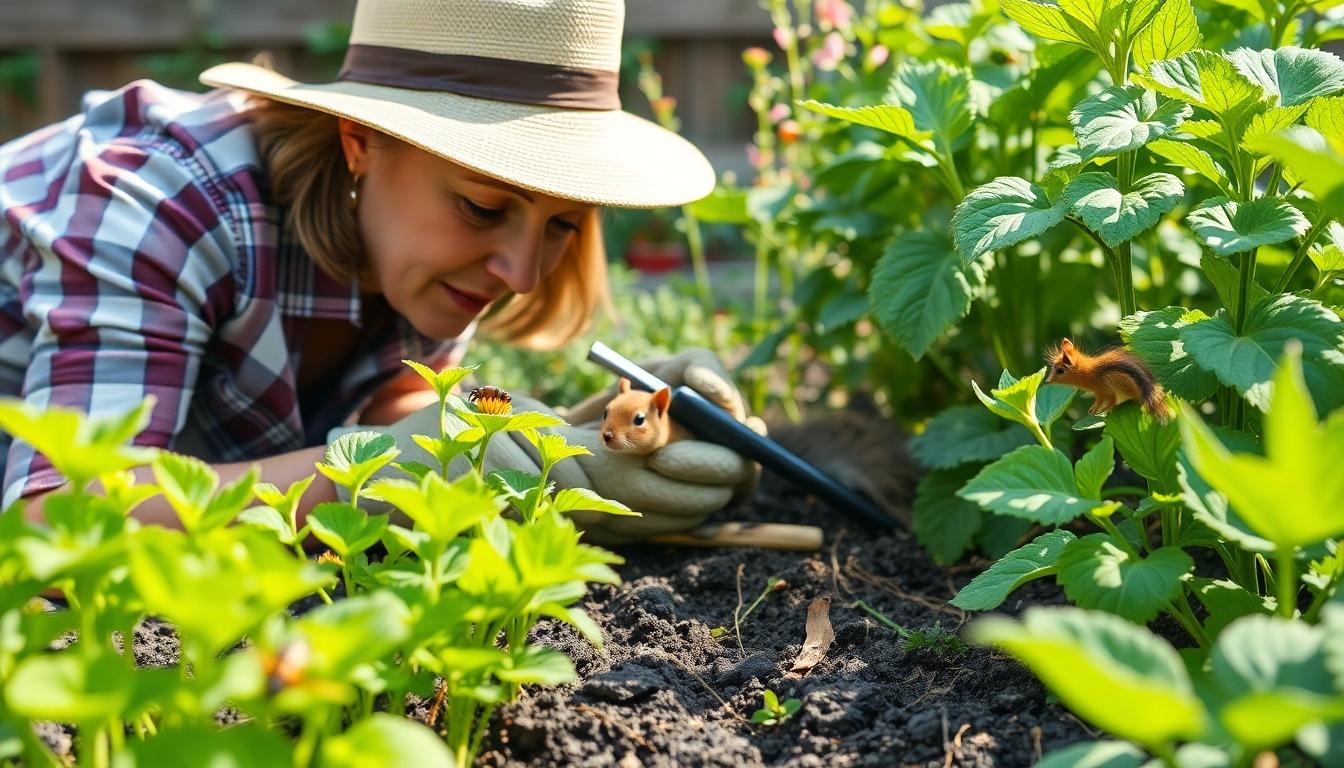
While gardens provide beauty and tranquility, they can also harbor various insect and animal threats that may damage plants or pose risks to gardeners. Understanding these potential dangers helps maintain both garden health and personal safety.
Identifying Dangerous Insects in Your Region
Several destructive insects commonly threaten garden spaces across different regions. Aphids, those small green insects, target new growth on plants and drain them of nutrient-rich sap, potentially causing important harm if not addressed promptly. Cutworms pose another serious threat as they cut through plant stems, often killing young seedlings and causing extensive damage to developing gardens. Slugs actively eat through plants, especially during nighttime hours, resulting in substantial damage to leaves and flowers that can compromise plant health. Understanding the exact pests common to your area requires careful observation of your plants and consultation with local gardening resources, which can provide region-exact information about prevalent threats.
How to Handle Wildlife Encounters Safely
Wildlife management requires strategic approaches to protect gardens without harming animals. Installing physical barriers such as fencing or protective mesh around gardens effectively deters animals like rabbits, deer, and groundhogs from accessing and damaging plants. Various repellents, both chemical and natural, can discourage unwanted wildlife from entering garden spaces when applied according to manufacturer recommendations. Motion-detecting systems that spray water when they detect movement serve as excellent deterrents, startling animals like squirrels and raccoons away from vulnerable plants. Particular attention should be paid to defending against groundhogs, which damage plants both above and below ground, and gophers, which primarily target plant roots causing structural damage to lawns and garden beds. Raccoons present unique challenges due to their dexterity, as they can often open garden containers to access plants and produce.
Hidden Structural Dangers in Garden Landscapes
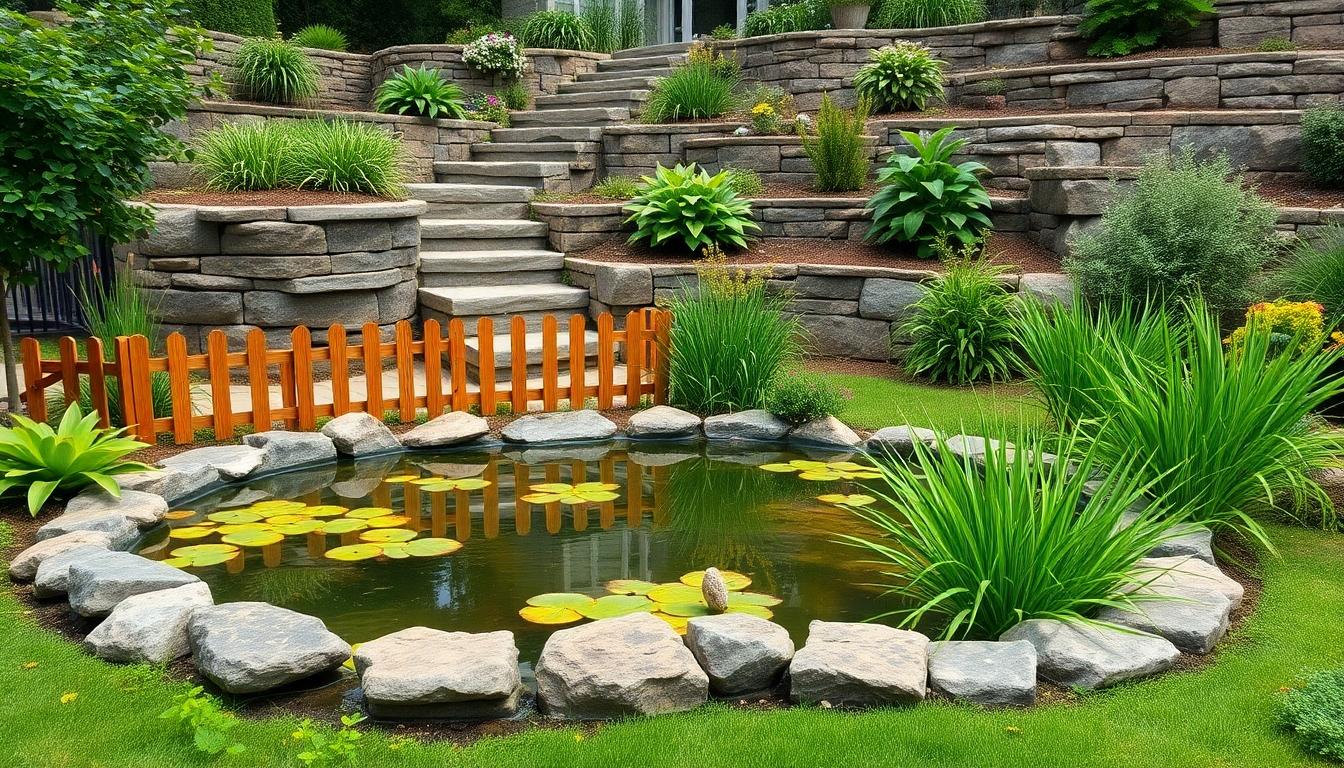
While creating beautiful outdoor spaces, we often overlook potential structural hazards that can compromise safety and cause important damage to property. These hidden dangers require careful consideration during industry design and installation.
Unstable Retaining Walls and Steps
Retaining walls can become serious safety hazards when improperly constructed. Poor drainage, erosion, and substandard materials frequently lead to wall collapse, resulting in soil displacement and extensive property damage. Professional design is essential for these structures to prevent failure from hydrostatic pressure or unexpected soil movement. Tall retaining walls on excavated slopes present particular challenges, often requiring costly engineering answers that might harm the environment through soil removal. A safer approach involves creating staggered steps combined with strategic planting for soil stabilization. Sloped gardens with inadequately terraced steps risk destabilizing not only the soil but also adjacent structures. Before undertaking any important retaining wall project, we strongly recommend obtaining a structural engineer assessment to ensure long-term safety and stability.
Water Features and Drowning Risks
Water features add tranquility to gardens but introduce important safety concerns when poorly designed. Ponds, fountains, and decorative pools lacking secure barriers or incorporating overly deep designs pose serious drowning risks, especially for children and pets. Proper safety measures include integrating shallow depth areas, installing non-slip surfaces around water features, and implementing appropriate barriers such as fencing or railings. Uncovered water storage containers present additional hazards that require attention during industry planning. Local safety regulations typically mandate exact protective measures for garden water installations, which vary by location and feature type. Always prioritize compliance with these codes when installing any water element in your industry to prevent potentially tragic accidents.
Allergenic Plants and Pollen Concerns
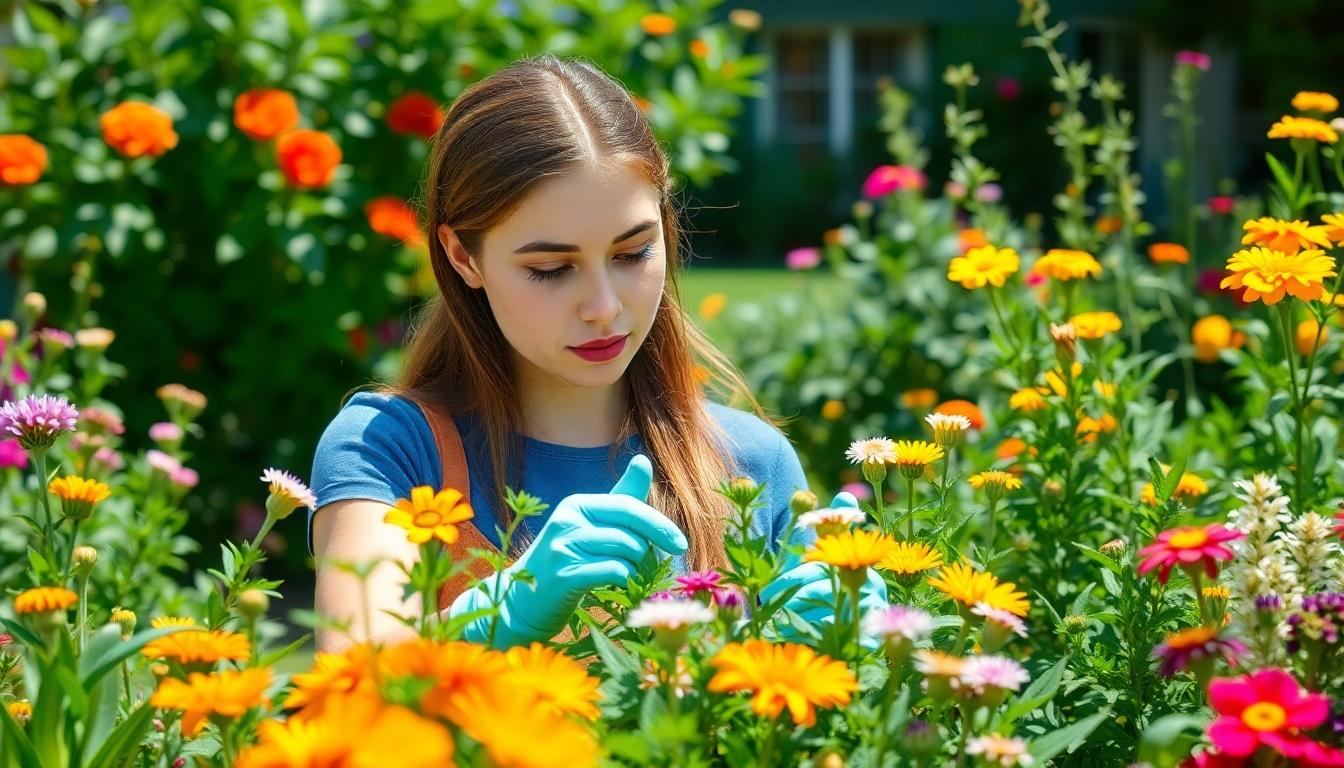
While gardens provide beauty and tranquility, they can also harbor many allergens that affect sensitive individuals. Many common garden plants release pollen and other substances that trigger allergic reactions in millions of people each year.
Identifying Common Allergens in Your Garden
Several types of plants and environmental factors can trigger allergic reactions in your garden space. Grasses like Bermuda, fescue, Johnson, and perennial rye are major allergy culprits that release abundant pollen during growing seasons. Many popular trees and shrubs also contribute significantly to seasonal allergies, including ash, birch, cedar, cypress, elm, maple, mulberry, oak, and willow trees. Weeds such as ragweed, cocklebur, pigweed, and sagebrush produce highly allergenic pollen that can travel for miles on the wind.
Flowers aren’t exempt from causing allergies either – chamomile, even though its reputation for calming effects, can trigger hay fever and skin reactions in individuals sensitive to ragweed, as both plants are related. Mold spores developing in overwatered soil or damp garden areas represent another common allergen that affects many gardeners. Plant sap and fragrances from certain species might cause skin irritation or respiratory reactions when handled or inhaled. Dust accumulation on plant leaves can also harbor allergens that become airborne when disturbed during garden maintenance.
Creating an Allergy-Friendly Garden Space
We can take several strategic steps to reduce allergen exposure while still enjoying a beautiful garden. Selecting low-allergen plant varieties forms the foundation of an allergy-friendly garden – choose plants that produce less pollen or have heavier pollen that doesn’t travel easily through air. Replace high-allergen plants with suitable alternatives, such as using woolly thyme instead of chamomile for ground cover applications.
Female cultivars of dioecious plants (those with separate male and female plants) produce no pollen and make excellent choices for allergy sufferers. Proper garden maintenance helps minimize allergen buildup – regular watering (without overwatering) keeps dust down and prevents dry conditions that allow pollen to spread more easily. Strategic plant placement can reduce allergen exposure; position high-allergen plants away from windows, doors, and frequently used outdoor seating areas.
Creating designated low-allergen zones allows sensitive individuals to enjoy outdoor spaces without suffering symptoms. Timing garden activities for low-pollen periods (typically early morning or after rain) helps reduce exposure during maintenance tasks. Wearing protective gear like gloves, long sleeves, masks, and sunglasses while gardening provides an additional barrier against allergens that might trigger reactions.
Weather-Related Garden Hazards
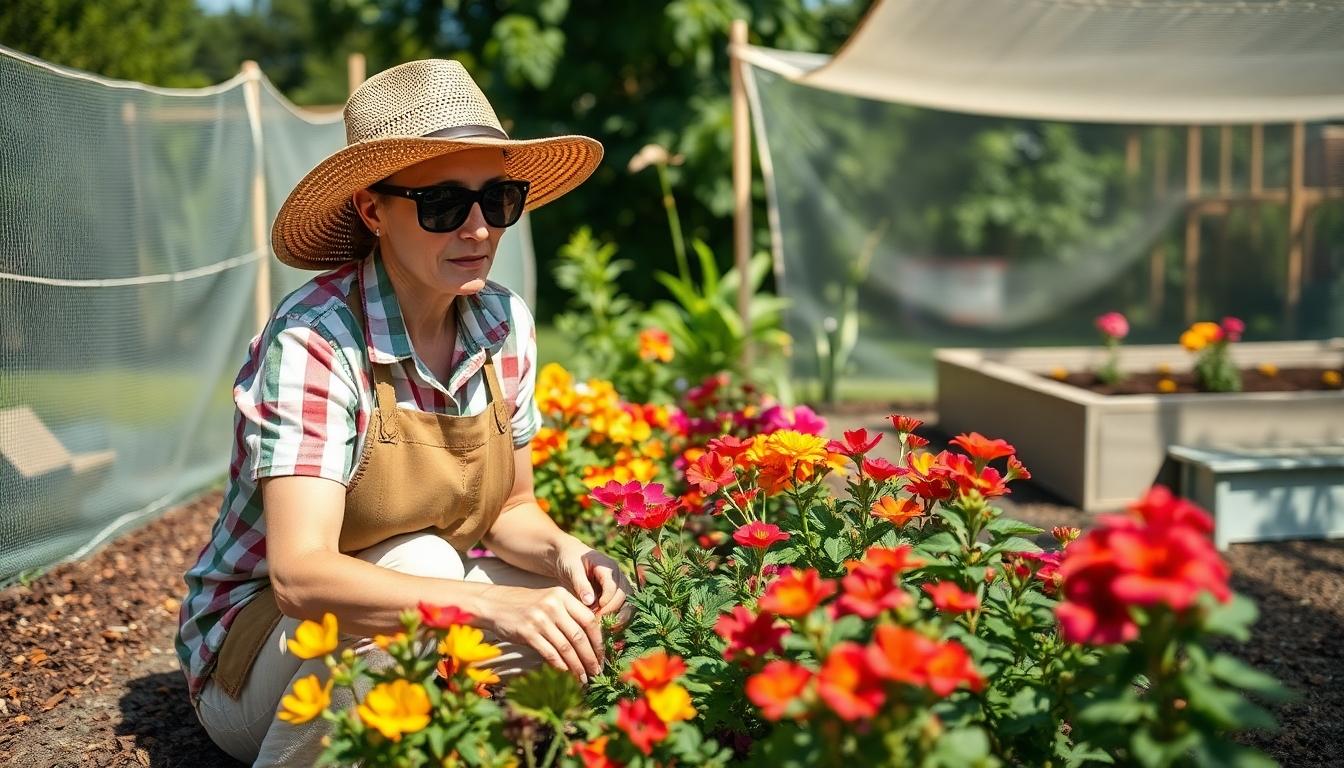
Gardens face many weather-related threats throughout the year that can damage plants and create safety hazards for gardeners. Extreme conditions can quickly transform your peaceful garden into a dangerous environment if proper precautions aren’t taken.
Protecting Your Garden During Extreme Conditions
Extreme heat significantly accelerates plant stress and increases fire risks, particularly in dry regions where vegetation becomes tinder. We’ve noticed that prolonged heat waves can cause irreversible damage to even established plants, making protection essential. Using shade cloths during peak sunlight hours provides crucial relief for vulnerable plants, while applying a thick layer of mulch helps retain soil moisture and regulate root temperature.
Heavy rainfall presents another serious threat to garden health, causing flooding, extensive soil erosion, and waterlogged roots that lead to root rot. Improving drainage through raised beds or strategically placed gravel trenches can prevent water accumulation around valuable plants. Directing downspouts away from garden beds ensures excess water doesn’t overwhelm your carefully planned industry.
Frost and sudden temperature drops damage sensitive plants almost instantly, often killing tender perennials or annual flowers overnight. Protecting vulnerable plants with frost blankets or cloches provides essential insulation during unexpected cold snaps. Row covers offer excellent protection for seedlings and young plants that haven’t developed cold tolerance yet.
Safety Measures for Outdoor Gardening in Heat
Sun protection must be your top priority when gardening during hot weather to prevent serious health risks. Wearing wide-brimmed hats and UV-blocking sunglasses shields your face and eyes from harmful rays, while applying broad-spectrum sunscreen every two hours prevents painful sunburn that can increase skin cancer risk.
Hydration requires constant attention during hot weather gardening sessions to prevent heat exhaustion or more serious heat-related illnesses. Scheduling gardening tasks for early morning or late afternoon allows you to avoid the most dangerous midday sun exposure while still accomplishing necessary garden maintenance.
Biological hazards increase during warm weather when insects become more active throughout garden spaces. Checking regularly for ticks, spiders, and stinging insects helps prevent painful bites and potential disease transmission. Wearing long sleeves and applying insect repellent creates an effective barrier between your skin and potentially harmful insects.
Chemical exposure risks increase when using treatments to combat heat-related garden problems. Using organic pesticides whenever possible reduces toxic chemical contact, while wearing gloves and masks when handling fertilizers or compost significantly decreases inhalation risks associated with these materials.
Physical hazards become more dangerous during extreme weather conditions when visibility or stability might be compromised. Inspecting your garden area for holes, uneven terrain, or stray tools prevents trips and falls that could be especially dangerous during hot weather when medical help might be delayed. Storing equipment properly after each use creates a safer garden environment regardless of weather conditions.
Legionella bacteria thrive in stagnant water that collects in hoses, sprinklers, or compost bags during warm weather. Regularly flushing water systems and avoiding the aerosolization of stagnant water prevents the potential spread of this harmful bacteria that can cause serious respiratory infections.
Dangerous Mushrooms and Fungi
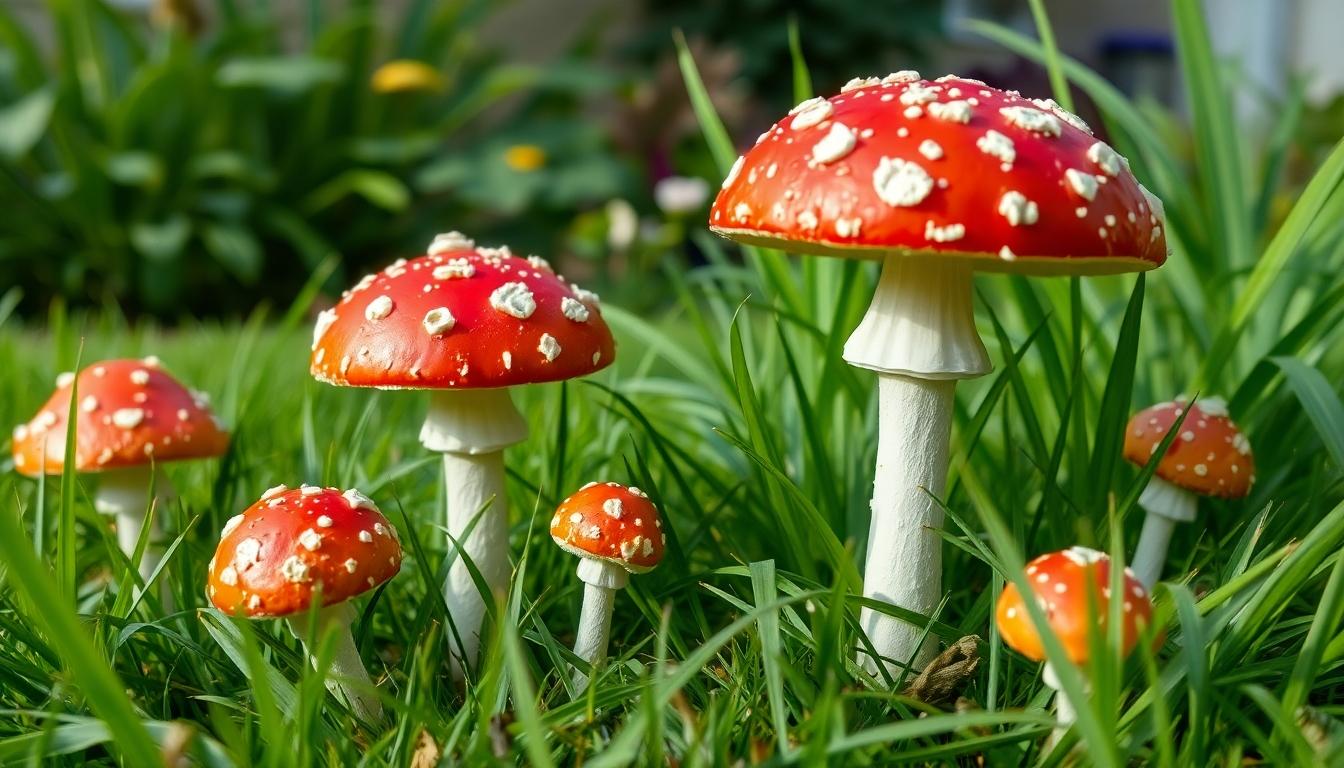
While garden mushrooms might seem harmless or even charming, some varieties pose serious health risks to humans and pets. Understanding how to identify and safely remove toxic fungi is essential for maintaining a safe outdoor space.
How to Identify Toxic Varieties
The Amanita species represent some of the most dangerous mushrooms in home gardens, with the Death Cap (Amanita phalloides) and Destroying Angel (Amanita muscaria) being potentially fatal. These deadly fungi contain toxins that can cause severe organ failure even with minimal consumption. Fly Agaric, recognizable by its distinctive red cap with white spots, produces serious gastrointestinal distress and impacts the circulatory system when ingested.
Several visual markers can help us identify potentially dangerous mushrooms. We should be particularly wary of fungi displaying white gills, rings or skirts on their stems, or bulbous bases known as volvas. Red coloration appearing on caps or stems frequently indicates toxicity and should trigger immediate caution.
Common misconceptions about mushroom safety can be dangerous. Contrary to popular belief, mushrooms that grow on wood aren’t automatically safe to consume—the Funeral Bell mushroom grows on wood yet contains lethal compounds. Similarly, the ability to peel a mushroom cap doesn’t guarantee it’s edible.
Never attempt to identify mushrooms solely by appearance or taste-test any unknown varieties, as even trace amounts of certain toxins like amatoxins can prove fatal. Professional identification through mycologists or specialized apps that analyze spore prints and habitat characteristics provides the safest approach.
Safe Removal Methods
Manual extraction remains the most effective way to remove toxic mushrooms from garden areas. We recommend wearing gloves and carefully uprooting the entire fungus, including the underground volva or base. Dispose of removed fungi in sealed bags to prevent spore dispersal that could lead to future growth.
Moisture control plays a crucial role in preventing mushroom proliferation. Reducing watering frequency and improving soil drainage creates less hospitable conditions for fungal development. Many toxic varieties thrive in damp environments, so maintaining drier soil can significantly decrease their presence.
Non-chemical treatment options offer environmentally friendly answers. Replacing contaminated soil or applying lime to adjust soil pH effectively deters exact species like the brick-red tear mushroom (Inocybe erubescens). These methods alter the growing environment without introducing harmful chemicals to your garden.
Avoid mowing over mushrooms as this action can spread spores throughout your garden. Complete removal of intact specimens prevents widespread contamination and reduces the likelihood of toxic mushrooms returning to the same area.
When handling unknown fungi, exercise extreme caution since even handling some varieties can cause skin irritation. Always wash hands thoroughly after garden work, especially after mushroom removal operations, to minimize potential exposure to toxins.
Soil Contaminants and Their Health Impacts

Urban gardens often harbor invisible threats beneath their fertile surface. Soil contaminants pose important health risks that many gardeners unknowingly expose themselves to daily.
Testing Your Garden Soil for Safety
Testing your garden soil is essential for identifying harmful contaminants that may be lurking underground. A single soil test might not provide complete information due to the patchy distribution of contaminants throughout garden spaces. Many experienced gardeners use lead as a sentinel indicator for detecting other potential pollutants, as its presence often signals the existence of additional harmful substances. To manage testing costs effectively, we recommend collecting multiple samples from key garden areas and combining them for a comprehensive analysis. If testing isn’t feasible due to budget constraints or limited access to testing facilities, it’s best to proceed as if contamination exists and carry out protective measures accordingly.
Remediation Options for Contaminated Soil
Several effective strategies exist for addressing soil contamination in your garden. Soil replacement involves completely removing contaminated soil and replacing it with clean fill, offering a comprehensive but labor-intensive solution. Phytoremediation utilizes specialized plants that naturally absorb and break down contaminants, providing an environmentally friendly alternative for less severe contamination. Capping techniques create a protective barrier by covering contaminated areas with clean soil or other protective materials to prevent exposure. Smart vegetation choices can minimize risk when full remediation isn’t possible, as certain plants absorb fewer contaminants than others. Practicing proper gardening hygiene, such as thorough hand washing after soil contact and careful produce cleaning, further reduces exposure risks when working with potentially contaminated soil.
Creating a Child and Pet-Safe Garden: Prevention Tips
While gardens provide beauty and tranquility they can harbor many hidden dangers. By taking proactive steps we can create safer outdoor spaces for our families and pets.
Always identify and remove toxic plants from accessible areas especially where children play. Store tools in locked sheds and properly label all garden chemicals keeping them out of reach.
Regular soil testing helps detect contaminants while installing proper drainage prevents standing water that attracts pests. Don’t forget to create barriers around water features and maintain stable structural elements.
With knowledge and vigilance we can enjoy our gardens while minimizing risks. The effort to create a safe garden pays dividends in peace of mind and protection for all who enjoy these special spaces.
Frequently Asked Questions
What are the most common toxic plants found in gardens?
Common toxic garden plants include Foxglove, Lily of the Valley, Sago Palms, Castor Bean Plants, and various Lilies. These plants can cause symptoms ranging from skin irritation to severe poisoning if ingested. Even small amounts of some toxic plants can be fatal to children and pets. Always research plants before adding them to your garden, particularly if you have curious children or animals.
How can I identify signs of plant poisoning?
Signs of plant poisoning vary but typically include gastrointestinal issues (vomiting, diarrhea, abdominal pain), respiratory problems (difficulty breathing, throat swelling), skin reactions (rashes, irritation), and neurological symptoms (confusion, seizures, dilated pupils). Symptoms can appear within minutes or hours after exposure. If you suspect poisoning, identify the plant if possible and seek immediate medical attention or call poison control.
What safety precautions should I take with garden tools?
Store tools in a designated, secure area away from children. Keep sharp tools sheathed and hung up rather than piled together. Regularly clean and maintain equipment to prevent accidents. When purchasing new tools, look for safety features like ergonomic designs, safety guards, automatic shut-off mechanisms, and non-slip handles. Always disconnect power tools when not in use.
Are chemical fertilizers and pesticides dangerous?
Yes, many synthetic fertilizers and pesticides contain harmful chemicals that can cause skin irritation, respiratory issues, and long-term health concerns including cancer. These chemicals also persist in the environment, damaging soil health and water systems. Consider switching to organic alternatives, implementing Integrated Pest Management (IPM), and conducting regular soil tests to minimize chemical use in your garden.
How can I protect my garden from harmful insects and animals?
For pest control, identify specific insects using local extension resources, then target treatments accordingly. Use physical barriers, companion planting, and biological controls before chemicals. For wildlife management, install fencing, use motion-detecting deterrents, and remove attractants like food sources. Consider habitat modification and strategically placed repellents to protect plants without harming beneficial wildlife.
What structural dangers should I be aware of in my garden?
Watch for unstable retaining walls that may collapse due to poor drainage or improper construction. Water features pose drowning risks, especially for children and pets. Assess garden paths and stairs for trip hazards, and check decks and pergolas for wood rot or structural weakness. Have large trees professionally evaluated for stability, particularly after storms or if they show signs of disease.
How can I create an allergy-friendly garden?
Select low-allergen plant varieties and avoid wind-pollinated plants that produce abundant pollen. Maintain regular garden hygiene by removing fallen leaves and debris. Consider the garden layout to minimize pollen concentration. Time your gardening activities for when pollen counts are lower, typically in the evening or after rain. Keep grass cut short and remove weeds promptly to reduce allergens.
What weather precautions should gardeners take?
Protect yourself in extreme heat by gardening during cooler hours, staying hydrated, and wearing sun protection. During storms, secure loose items and avoid staying in the garden. For your plants, use shade cloths in heat, improve drainage for heavy rains, and apply frost blankets during cold snaps. Always check weather forecasts before applying chemicals or starting major garden projects.
How dangerous are wild mushrooms in gardens?
Wild mushrooms can be extremely dangerous, with some varieties like Death Cap and Destroying Angel being potentially fatal if ingested. Never consume any wild mushroom without expert identification. Remove mushrooms promptly, especially in areas accessible to children and pets. Wear gloves when handling them and minimize moisture in problem areas to discourage growth. Consider professional help for persistent mushroom issues.
How do I deal with soil contamination in my garden?
Test your garden soil through a reputable laboratory, taking multiple samples from different areas. If contamination is found, remediation options include soil replacement, raised beds with clean soil, phytoremediation using specific plants, or capping techniques. Always wear gloves when gardening, wash produce thoroughly, and practice good hygiene to minimize exposure to soil contaminants.

